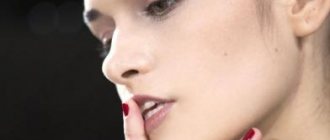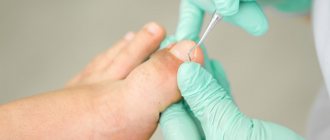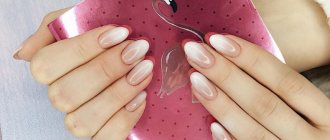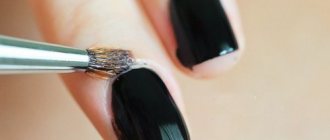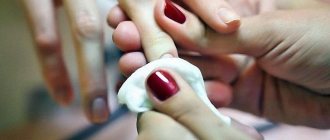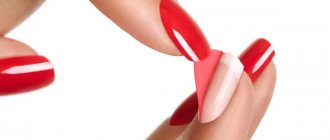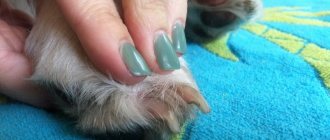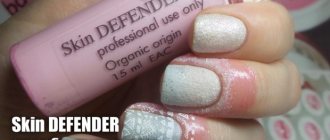Broken nail: what to do
What to do next with a broken nail depends on how it broke: slightly cracked or completely torn off. An uneven edge or crack will cause trouble - scratching and clinging to clothes.
Possible actions in case of a broken nail are as follows:
Nail broken at the edge
- Trim or file the nail.
- Glue the crack yourself.
- Seek help from a specialist.
If you want to solve the problem yourself and save a broken nail yourself at home, then you need to choose the right gluing technology. It depends on where the crack is: in the overhanging part of the nail or in the middle of it. The size of the crack is also important.
- If the damage is minor , then you can seal the problem area with a special patch made of natural fabric or paper plaster. This repair is used for any cracks on the side of the nail, along the “smile” line or along it.
- When the nail is completely broken off, an acrylic artificial material is applied tips .
- Tips are also applied when a crack appears along the axis of the finger, in the middle.
It makes sense to repair a broken nail if it is cracked no more than 1/3 of its length. Otherwise, the repair will be short-lived.
Sometimes the crack goes so deep that it injures the finger under the nail. In this case, it is better to carry out treatment and recovery in the salon.
What not to do :
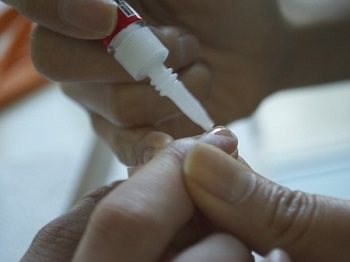
Do not apply superglue to an uncoated natural nail.
- Glue a living natural nail with superglue . The synthetic composition corrodes living cells of the nail plate. Only extended acrylic plates can be repaired with synthetics.
- Do not treat the nail with acetone or other nail polish remover when breaking it off to the “meat”. Aggressive chemical solutions should not get into the wound.
- Don't delay repairing your nail if you have a crack. The nail may crack further and break off completely. The sooner you start fixing the problem area of the nail, the smaller the crack that needs to be repaired.
How to choose a polygel?
The choice of polygel depends on the final color you want to achieve (darker, lighter or transparent), as well as on the consistency you prefer to work with. But still, there are 2 general recommendations:
- It is better to purchase materials from leading brands that have already proven themselves and received many positive reviews. These are ruNail, BHM, EMI, Imen, Monami Professional and others.
- Acrigel must be purchased from a trusted store so as not to accidentally become the owner of a fake. Fake information can lead to severe allergies and nail diseases.
Attention: only certified products that have passed multi-stage testing are presented in ParisNail online and retail stores!
Tools and materials for nail repair
Often, materials for gluing damaged nails are sold as a set, like a professional kit for repairing nail plates. It includes:
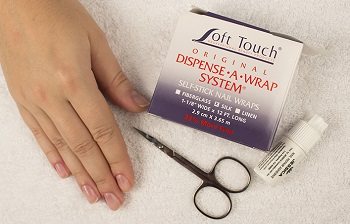
The main materials for nail repair are silk and special glue.
- Silk for nail repair on an adhesive basis.
- Glue for natural and artificial nails.
- File and buffer for natural and artificial nails.
- Any disinfectant : hydrogen peroxide, medical alcohol, or even better - a professional manicure product.
- Orange sticks for manicure.
All these tools and materials can be selected separately, depending on availability in the store and personal preferences. It is worth noting that although the special nail repair silk is self-adhesive, its adhesive base is not enough to glue the crack, nail glue is required.
In the absence of silk for nails, it can be replaced with a piece of natural or synthetic silk, a paper napkin, a tea bag, filter paper or a paper plaster - whatever you have at hand at home.
Natural nail repair
Most often, the nail plate breaks at the point where it attaches to the finger. This line is called a "smile". The repaired nail loses its strength, but retains its appearance. The repair technology is as follows:
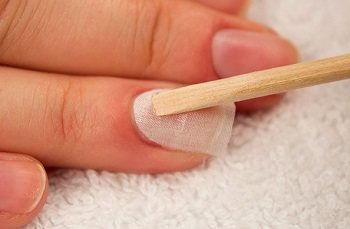
Nail repair process
- Remove the polish and treat the nail with an antiseptic .
- Apply a buff to any uneven areas on the broken nail.
- Prepare a piece of fabric - cut it so that it covers the crack by 2-3 mm on each side.
- Apply glue and place a piece of fabric over the nail , pressing it carefully. To level the patch, use a toothpick or an orange stick with a pointed end.
- After the glue has dried, smooth the edges of the fabric with a buffer .
- Similarly, glue another 1-2 layers of fabric on top of the first, depending on the size of the breakage, carefully filing each layer
- Cover the nail with varnish to completely disguise the crack.
You can learn more about how to repair a broken nail by watching this video:
When gluing tips, the technology is similar. Instead of three layers of fabric patches, an acrylic tip is glued over the damage. After the glue has dried, the tips are cut to the required size.
[adsense_content_2]
Causes of fragility
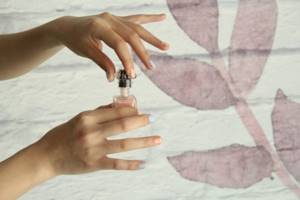
Brittle nails can be caused by both external and internal reasons. After the nail is repaired and the threat has passed, be sure to analyze the situation and determine whether the reasons listed below are appropriate in your case:
- unbalanced diet and lack of vitamins. Vitamin deficiency is a common cause of fragility. The nail plate becomes thinner and becomes vulnerable to external influences - mild mechanical shocks, snags on clothing;
- mechanical impact - a one-time impact on a hard surface;
- systematic mechanical influences, for example, working on a keyboard;
- coating without a base coat;
- hand contact with high or low temperatures.
Nail structure and growth: what healthy nails and skin should look like, care rules
Nail health during manicure and pedicure: what a novice master should pay attention to
Crack under gel coating
In order to glue the nail under the gel polish, you need to remove the polish. You don’t have to remove all your fingers, limit yourself to just the broken nail, and leave the rest alone. For removal, use special means for removing Shellac or biogel, depending on the coating of the nail. If you can’t remove the gel polish, you can glue a patch over the old coating.
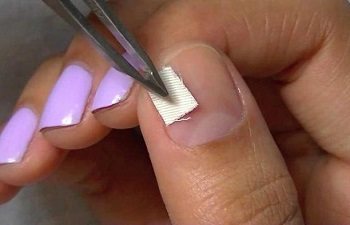
A “patch” is applied to the place where the nail is broken.
The technique of applying a patch to gel polish is the same as for a natural nail, and it is covered with a new varnish, which is dried under a UV lamp. For home repairs using gel technology, you need a UV lamp and gel polish.
If the crack is located along the edge of the nail, then it can be cut off and rebuilt with biogel . To do this, use a special form or foil, which is placed under the nail and used as a support for applying the biogel. After the biogel hardens under a UV lamp, the foil is carefully removed.
How to build up a broken nail with biogel or a rubber-based base coat, see the video instructions:
Acrigel
Acrigel (combigel, acrylic, polygel) - all these names belong to a universal material created on the basis of acrylic and gel. The material has absorbed their best qualities: gel plasticity and acrylic strength, and even surpassed them.
Extended nails are distinguished by their elegance, natural appearance, and effectiveness, on par with a professional salon manicure. The procedure allows you to quickly increase length. At the same time, the coating is very durable. The best polygel manufacturers are Irisk Professional, Bluesky Pudding Gel, Tnl Professional, Soline Charm.
Benefits of acrygel for nail extensions:
- The elasticity is superior to hard gels, the strength and lightness are higher than that of arkyl. There is no effect of squeezing the nail plate. Despite the high degree of density, the material is not felt on the nails and does not weigh them down, so it can be used on weakened nail plates.
- The dense and viscous consistency of the material allows you to give surfaces the correct architecture and ideal shape, thereby reducing material waste and saving time on the filing process.
- Acrylic causes 50% less burning when polymerized in a UV lamp, even when modeling very long and dense nails. There are no harmful fumes.
- Acrygel does not spread, so there is no risk of accidental contact with skin. This sets it apart from regular gel.
- The dust created when filing acrylic materials is 30% heavier than regular gel or acrylic. When working, it does not fly apart, but settles on the skin and table. This property reduces the risk of contact and respiratory allergies of the nail artist and the client.
- Unlike acrylic, acrylic does not require the artist to follow strict proportions of combining powder with monomer.
- Excellent adhesion of acrylic with primer and base, as well as any type of varnish, allows you to avoid peeling.
- Acryl Gel can only harden under a lamp. Therefore, you should not be afraid of sunlight hitting an open jar of acrylic. This is its advantage over acrylic.
- Combigel is very economical. One layer of material allows you to obtain a uniform and dense coating. There is no need to purchase separate brushes. Those used in working with gel and acrylic are suitable. The absence of an unpleasant odor allows the master to do without a separate office.
Note! The correct shape is created both by directly applying the material to the nail plate and by using accessories: regular or liquid tips, reusable forms. Combigel lasts until correction is required due to overgrown natural nails.
Nail extension repair
Extensions are done with acrylic tips . They do not have a living structure, so if they break off, they can be glued with synthetic glue for plastic (superglue, “Moment”). The fastening materials are the same - filter paper, silk strips, paper plaster.
The technology for gluing the extended plate is as follows:
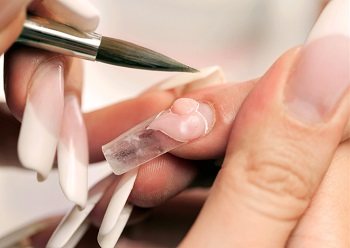
If repairing the extended nail is impossible, you can replace it with a new one.
- Apply glue to the nail and place paper strip on top of it .
Place another drop of glue . the third layer of glue on top of the dried second. - Treat the repair area with a nail file .
- Apply varnish on top .
Another repair option is to replace the broken tip with a new one.
Should I use primer and dehydrator with polygel?
It is recommended to use the dehydrator only on very wet nails. Because The dehydrator removes moisture deeply enough; it cannot be used for dry nails. Primer from Lovely is acid-free, but nevertheless, even it should not be used recklessly. It is recommended to be used for clients whose nails are prone to peeling (taking antibiotics, hormonal and pre-medicine medications, health problems, etc.). You can apply the primer not to the entire nail, but to a third of the nail and the end. Important! Apply once, in a thin layer, avoiding contact with the skin. The dehydrator and primer are air dried.
